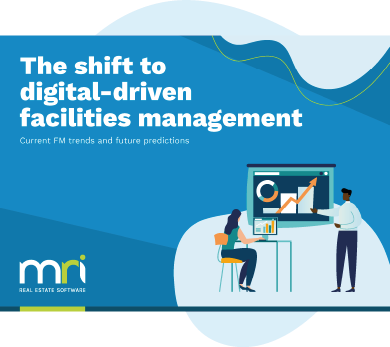How does a building management system work?
At MRI Software, we develop forward-thinking software solutions for people in property, and in this article, we’re going to focus on the intricate mechanics of how building management systems work. These systems are pivotal in modern facilities management, enabling streamlined operations across multiple property portfolios. By integrating sophisticated technology with practical applications, MRI Software enhances the way buildings are maintained and managed.
The benefits of building management systems are extensive, ranging from increased operational efficiency to significant cost savings. Using building maintenance software within these systems not only simplifies the management tasks but also ensures that every aspect of building operations is optimized. This integration leads to a proactive approach in maintaining building health, ultimately benefiting both property managers and occupants.
Components of a building management system
Let’s explore some of the key components of a building management system and how they each function individually and together.
Sensors and actuators
In a building management system, sensors play a crucial role by constantly monitoring various environmental parameters within your building. These include temperature, humidity, light levels, and energy usage, among others. The data collected by these sensors is then used to maintain optimal conditions automatically and efficiently. This real-time monitoring is key to ensuring comfort and operational efficiency within the premises.
Actuators are the devices that respond to the commands from the system’s control unit, based on the information provided by the sensors. They adjust the building’s operations by controlling heating, ventilation, air conditioning (HVAC) systems, lighting, and other mechanisms. By effectively responding to the changes in monitored conditions, actuators help you maintain a desirable environment while also enhancing energy efficiency. This integration of sensors and actuators is fundamental in a BMS, allowing you to manage your building’s environment.
Control panel
Control panels serve as the operational hub of a building management system, providing a central point from which you can oversee and control the various subsystems within your building. These panels display data collected from sensors and allow manual inputs for overriding automatic settings, ensuring you have complete command over the building’s operations.
They facilitate seamless communication between different systems, such as HVAC, lighting, and security, enabling integrated management. With intuitive interfaces, these panels empower you to make informed decisions quickly, optimizing the efficiency and safety of your building.
Communication networks
Communication networks are the backbone of building management systems, enabling seamless interaction between sensors, actuators, and control panels. These networks, whether wired or wireless, transmit data across various building components, ensuring that information flows efficiently from one point to another. This connectivity is essential for real-time monitoring and control.
By employing robust communication protocols, your BMS can maintain reliable and secure connections, essential for the system’s performance and your building’s operational integrity. This interconnectedness allows for swift adjustments and proactive management of building conditions.
Software and algorithms
Software and algorithms are the intelligence layer of a building management system, designed to interpret data from the building’s environment and make decisions to optimize operations. This software analyses the inputs from sensors to detect patterns, predict future needs, and automate responses, significantly enhancing efficiency and comfort.
These algorithms are constantly learning and adapting to your building’s unique operational dynamics. This adaptability not only improves energy efficiency but also ensures that the environmental conditions are consistently maintained at optimal levels, providing a smarter, more responsive management system.
How does a building management system work?
A building management system (BMS) orchestrates the various functions within a building to ensure optimal operational efficiency and comfort. At its core, a BMS integrates hardware and software to monitor and control the building’s mechanical and electrical equipment. This system gathers data from sensors placed throughout the building, which it uses to maintain ideal conditions and streamline building operations.
Key components of a BMS include:
- User interface: Provides an accessible platform for managing settings and viewing system status.
- Database systems: Store and manage historical data for trend analysis and reporting.
- Security integration: Coordinates with security systems to enhance building safety.
- Maintenance scheduling tools: Automate and track maintenance activities to prevent equipment failures.
Through these elements, a BMS reduces energy consumption, enhances safety, and improves the overall management of building utilities, making it an indispensable tool for building managers.
Functionality of a building management system
A building management system has a range of functions that makes it easier and more efficient to look after your building and its occupants.
Monitoring
Monitoring is a fundamental functionality of a building management system, enabling you to continuously observe and assess the performance of all connected systems within your building. This constant vigilance helps in detecting inefficiencies and potential issues before they escalate, ensuring that everything from HVAC to lighting operates optimally.
The BMS achieves this through an extensive network of sensors that feed real-time data into the system. This data is then analyzed to provide actionable insights, allowing you to make informed decisions to maintain or improve building operations efficiently.
Control
Control is a critical functionality of a building management system, allowing building managers like you to command various building operations directly. This system capability ensures that you can adjust settings for HVAC, lighting, and other systems to meet the specific needs of the building’s occupants and operational requirements, all from a centralized interface.
By integrating control functions, a BMS enables automated responses to the data received from sensors, enhancing both comfort and energy efficiency. These automated controls adapt in real-time, aligning with environmental changes and occupancy patterns, thus optimizing overall building performance.
Optimization
Optimization is a key functionality of a building management system (BMS), designed to enhance building operations for maximum efficiency and minimal waste. Through the use of advanced algorithms, the BMS continuously adjusts the settings of various systems based on real-time data, ensuring that energy usage is kept to a minimum while maintaining optimal comfort levels.
This process not only reduces operational costs but also extends the lifespan of building equipment by avoiding unnecessary strain. The BMS makes strategic adjustments to improve performance, tailored to the unique dynamics and usage patterns of your building.
Reporting and analysis
Reporting and analysis are vital functionalities of a building management system (BMS), providing you with detailed insights into the performance of your building’s systems. This feature compiles data collected from various sensors and systems into comprehensive reports, allowing you to assess efficiency, detect anomalies, and identify areas for improvement.
These analytical capabilities support data-driven decision-making, helping you to optimize operations and reduce costs. With regular and accurate reports, you can track trends over time, forecast future needs, and ensure compliance with environmental standards and regulations.
Building management systems FAQs
Let’s explore some of the common FAQs around building management systems.
Facilities Management Software
Leading solutions for property occupiers, owners and service providers & contractors.

Contact MRI Software
If you want to know more about how our software solutions can help with your property journey, contact us today.
The shift to digital-driven Facilities Management
Introduction Historically, the success of the FM function was measured by its ability to keep things running behind the scenes. With new and urgent industry challenges bringing facilities management into the limelight, this is no longer the case. Fac…
